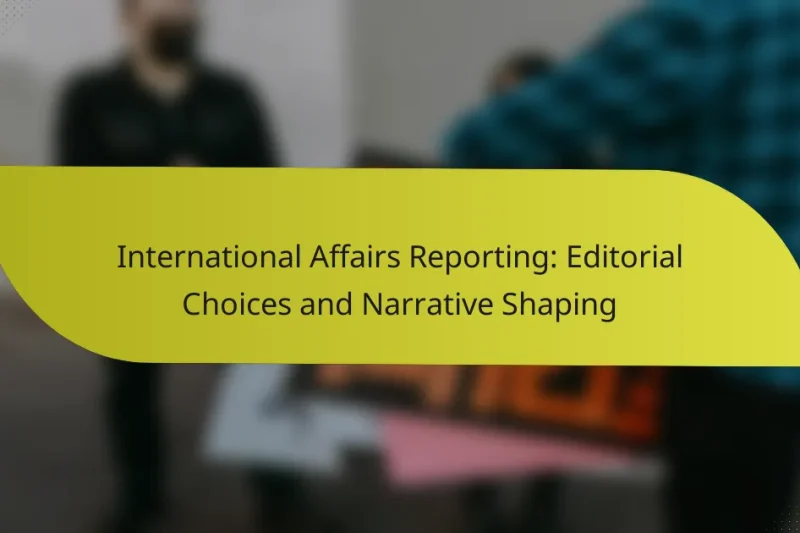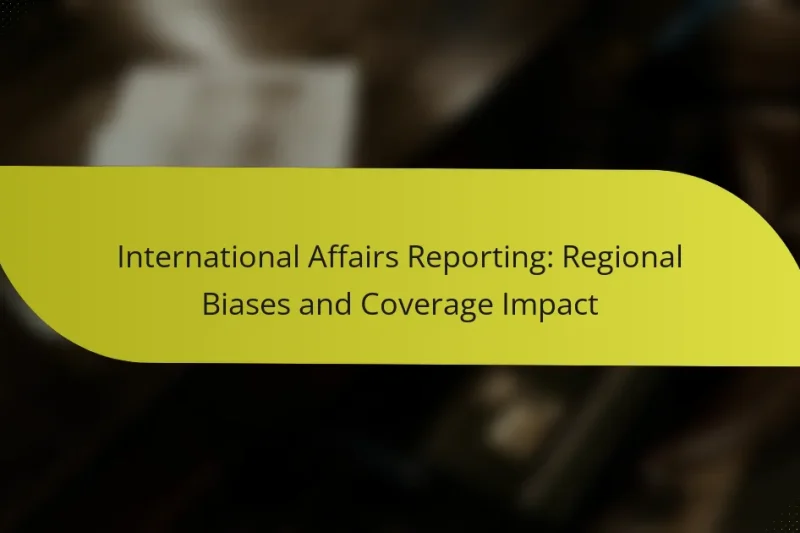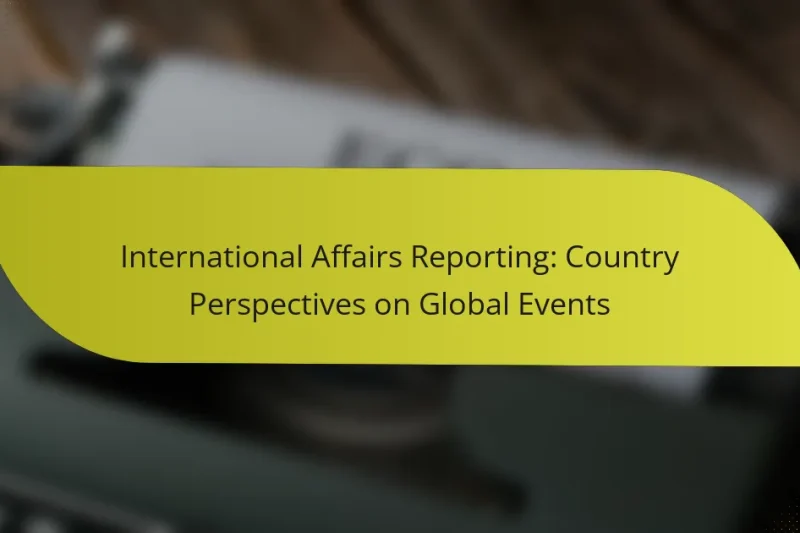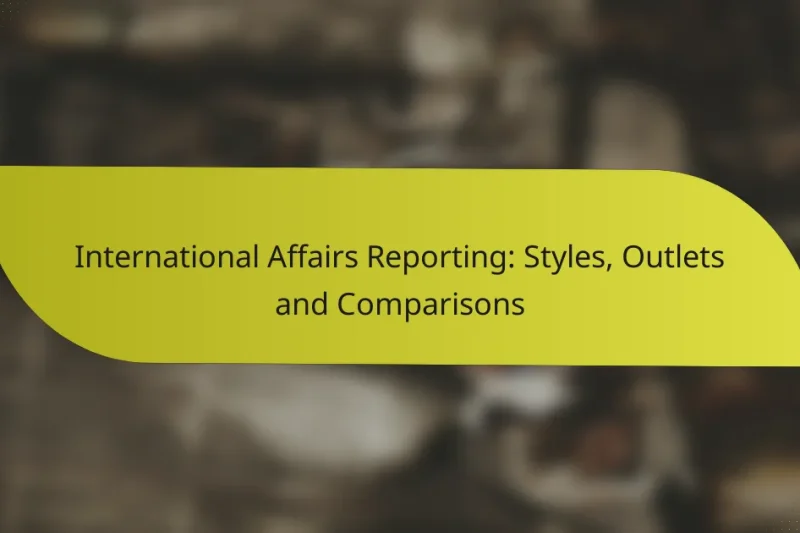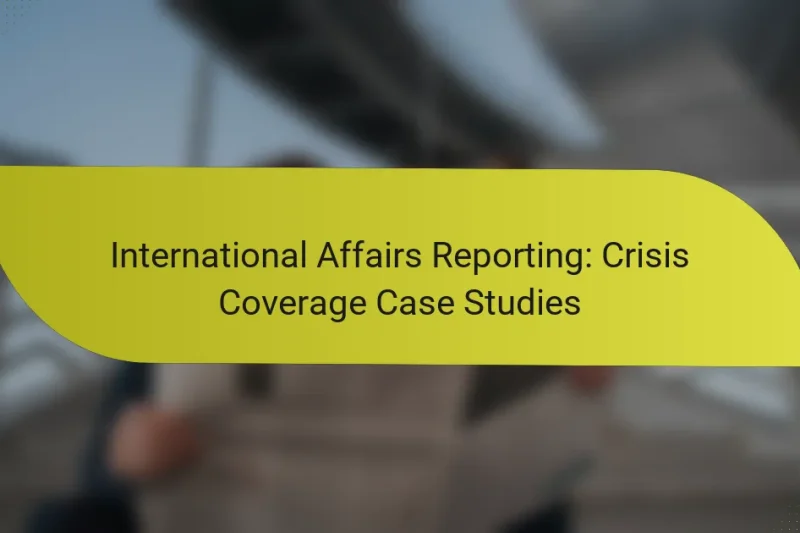Editorial choices play a crucial role in shaping international affairs reporting, influencing which stories are highlighted … International Affairs Reporting: Editorial Choices and Narrative ShapingRead more
Comparative Analysis in International Affairs Reporting
Comparative analysis in international affairs reporting is essential for understanding the complexities of global issues. By utilizing diverse data sources and integrating multiple perspectives, journalists can create a more nuanced narrative that respects cultural sensitivities. Implementing best practices such as rigorous fact-checking and engaging with local experts further enhances the credibility and integrity of the reporting.
International Affairs Reporting: Regional Biases and Coverage Impact
Regional biases play a crucial role in shaping international affairs reporting, affecting the portrayal of events … International Affairs Reporting: Regional Biases and Coverage ImpactRead more
International Affairs Reporting: Formats, Effectiveness and Analysis
International affairs reporting plays a crucial role in shaping public understanding of global events and foreign … International Affairs Reporting: Formats, Effectiveness and AnalysisRead more
International Affairs Reporting: Country Perspectives on Global Events
International affairs reporting varies significantly across countries, shaped by unique cultural, political, and economic contexts. These … International Affairs Reporting: Country Perspectives on Global EventsRead more
International Affairs Reporting: Styles, Outlets and Comparisons
International affairs reporting plays a crucial role in shaping public understanding of global issues, utilizing various … International Affairs Reporting: Styles, Outlets and ComparisonsRead more
International Affairs Reporting: Crisis Coverage Case Studies
International affairs reporting during crises requires a strategic blend of real-time techniques and local insights to … International Affairs Reporting: Crisis Coverage Case StudiesRead more
International Affairs Reporting: Evaluating Credibility of News Sources
In today’s interconnected world, evaluating the credibility of international news sources is essential for informed decision-making. … International Affairs Reporting: Evaluating Credibility of News SourcesRead more
What are the best practices for comparative analysis in international affairs reporting?
Best practices for comparative analysis in international affairs reporting involve using a variety of data sources, integrating multiple viewpoints, and ensuring cultural sensitivity. These elements help create a comprehensive and balanced understanding of complex global issues.
Utilizing diverse data sources
To conduct effective comparative analysis, it is crucial to gather information from a wide range of data sources. This can include government reports, academic studies, media articles, and expert interviews. Relying on diverse sources enhances the reliability of the analysis and provides a more nuanced view of international affairs.
Consider incorporating quantitative data, such as economic indicators or demographic statistics, alongside qualitative insights from local experts. This combination allows for richer comparisons and a deeper understanding of the context surrounding the issues at hand.
Incorporating multiple perspectives
Incorporating multiple perspectives is essential for a well-rounded comparative analysis. Engaging with viewpoints from different stakeholders, including governments, NGOs, and local communities, helps to illuminate various facets of an issue. This approach can reveal biases and assumptions that may otherwise go unchallenged.
To effectively include diverse perspectives, consider conducting interviews or surveys with individuals from different backgrounds. This can provide firsthand insights that enrich the analysis and highlight the complexity of international relations.
Ensuring cultural sensitivity
Cultural sensitivity is vital in comparative analysis, as it acknowledges the diverse values and beliefs that shape international affairs. Reporters should be aware of cultural nuances and avoid imposing their own biases when interpreting data or presenting findings.
To ensure cultural sensitivity, familiarize yourself with the cultural context of the regions being analyzed. This may involve understanding local customs, historical grievances, and social dynamics that influence political behavior. Being respectful and informed can significantly enhance the credibility of the reporting.
Employing analytical frameworks
Using analytical frameworks can help structure comparative analysis and clarify complex relationships between different factors. Frameworks such as SWOT (Strengths, Weaknesses, Opportunities, Threats) or PESTLE (Political, Economic, Social, Technological, Legal, Environmental) can provide a systematic approach to evaluating international issues.
When applying these frameworks, ensure they are tailored to the specific context of the analysis. This customization allows for more relevant insights and can guide the interpretation of data in a way that is meaningful to the audience.
Maintaining objectivity
Maintaining objectivity is crucial in comparative analysis to ensure that findings are credible and trustworthy. Reporters should strive to present facts without personal bias, allowing the data to speak for itself. This involves critically evaluating sources and being transparent about any potential conflicts of interest.
To uphold objectivity, consider implementing a peer review process where colleagues can assess the analysis for bias or inaccuracies. This collaborative approach can enhance the quality of the reporting and foster a culture of accountability in international affairs journalism.
How can journalists enhance credibility in international affairs reporting?
Journalists can enhance credibility in international affairs reporting by implementing rigorous fact-checking, accurately attributing sources, and engaging with local experts. These practices not only build trust with audiences but also ensure the integrity of the information being presented.
Fact-checking and verification
Fact-checking and verification are essential steps in maintaining credibility. Journalists should cross-reference information from multiple reliable sources before publication. Utilizing established fact-checking organizations can also provide an additional layer of validation.
When reporting on international events, consider the context and potential biases of sources. For instance, a report from a government agency may have different implications than one from an independent NGO. Always assess the credibility of the source and the data provided.
Attributing sources accurately
Accurate attribution of sources is crucial for transparency and accountability. Journalists should clearly identify the origin of information, whether it comes from official statements, eyewitness accounts, or expert analyses. This practice helps readers gauge the reliability of the information presented.
When attributing sources, use direct quotes when possible, and provide context about the source’s background. For example, stating that a comment comes from a recognized expert in international relations adds weight to the information. Avoid vague references like “some say” which can undermine credibility.
Engaging with local experts
Engaging with local experts can significantly enhance the depth and accuracy of international reporting. Local experts often have insights that are not available through mainstream sources, providing a richer understanding of the issues at hand. This engagement can also help journalists avoid cultural misunderstandings.
To find local experts, journalists can reach out to universities, think tanks, or community organizations. Building relationships with these individuals can lead to more informed reporting and a network of reliable contacts for future stories. Always verify the credentials of the experts to ensure their authority on the subject matter.
What tools are available for comparative analysis in international affairs?
Several tools facilitate comparative analysis in international affairs, helping researchers and journalists evaluate data across different countries and contexts. These tools include data visualization software, statistical analysis tools, and content management systems, each serving distinct purposes in the analysis process.
Data visualization software
Data visualization software transforms complex data sets into visual formats, making it easier to identify trends and patterns. Tools like Tableau and Microsoft Power BI allow users to create interactive dashboards that can compare various international metrics, such as economic indicators or social statistics.
When selecting data visualization tools, consider the types of data you need to present and the audience’s familiarity with visual data. Ensure that the software can handle the volume of data you intend to analyze and visualize.
Statistical analysis tools
Statistical analysis tools, such as R and SPSS, are essential for conducting rigorous comparative analyses. These tools enable users to perform complex statistical tests, analyze relationships between variables, and interpret data accurately.
For effective use, familiarize yourself with the statistical methods relevant to your analysis. Always validate your data sources and ensure compliance with ethical standards in data handling, especially when dealing with sensitive international information.
Content management systems
Content management systems (CMS) like WordPress and Drupal are vital for organizing and publishing comparative analysis reports. A robust CMS allows for the integration of various data sources and visualization tools, streamlining the reporting process.
When choosing a CMS, prioritize user-friendliness and the ability to customize features that support comparative analysis. Regularly update your CMS to incorporate the latest security features and plugins that enhance data presentation and accessibility.
What are the challenges faced in international affairs reporting?
International affairs reporting faces several significant challenges that can impact the accuracy and reliability of information. Key issues include access to reliable information, language barriers, and political biases that can distort the reporting process.
Access to reliable information
Accessing reliable information is crucial for accurate international affairs reporting. Journalists often struggle to obtain firsthand accounts or verified data, especially in conflict zones or authoritarian regimes where information is tightly controlled.
To mitigate this challenge, reporters should utilize multiple sources, including local contacts, NGOs, and international organizations. Fact-checking and cross-referencing information can help ensure that the reporting is credible and well-rounded.
Language barriers
Language barriers can significantly hinder effective communication in international affairs reporting. Journalists may encounter difficulties in understanding local dialects or nuances, which can lead to misinterpretations of critical information.
Employing skilled translators or local journalists who are fluent in both the source and target languages can enhance clarity. Additionally, using simple language and avoiding idiomatic expressions can help bridge communication gaps.
Political biases
Political biases can skew the portrayal of events in international affairs reporting. Media outlets may have affiliations or leanings that influence how stories are framed, potentially leading to a lack of objectivity.
To counteract this, reporters should strive for balanced perspectives by including diverse viewpoints and presenting facts without sensationalism. Awareness of one’s own biases and actively seeking out opposing opinions can also contribute to more impartial reporting.
How does comparative analysis influence public perception of international issues?
Comparative analysis shapes public perception of international issues by highlighting differences and similarities between countries or regions. This method helps audiences understand complex global dynamics, often influencing opinions and policy discussions.
Understanding Comparative Analysis in International Affairs
Comparative analysis in international affairs involves evaluating various countries or regions to draw insights about their political, economic, and social systems. By comparing factors such as governance, economic performance, and social stability, analysts can identify patterns that inform public understanding and media narratives.
For example, comparing healthcare systems in the U.S. and Canada can reveal how different policies affect public health outcomes. Such comparisons not only educate the audience but also provoke discussions about which systems might be more effective or equitable.
The Role of Media in Shaping Perceptions
Media plays a crucial role in disseminating comparative analyses, often framing issues in ways that resonate with audiences. By selecting specific comparisons, media outlets can emphasize particular narratives, such as the effectiveness of democratic governance versus authoritarian regimes.
For instance, a report contrasting the economic recovery strategies of Germany and Greece during a financial crisis can influence public opinion on fiscal responsibility and governance. The way these comparisons are presented can significantly sway perceptions about national policies and international relations.
Challenges and Limitations of Comparative Analysis
While comparative analysis is valuable, it comes with challenges. Oversimplification can lead to misleading conclusions, as complex issues may not be adequately represented by direct comparisons. Analysts must consider cultural, historical, and contextual factors that influence outcomes.
Moreover, the selection of countries for comparison can introduce bias. For example, comparing a developed nation with a developing one may not provide a fair assessment of policies or outcomes. Analysts should strive for balanced comparisons to avoid skewed perceptions.
Practical Applications of Comparative Analysis
To effectively use comparative analysis in reporting, journalists should focus on clear, relevant comparisons that resonate with their audience. This can involve using visual aids like charts or tables to illustrate differences in key metrics, such as GDP growth rates or education levels.
Choose comparable countries or regions with similar contexts.
Highlight significant differences that impact public perception.
Use clear visuals to enhance understanding.
By following these guidelines, media professionals can enhance the clarity and impact of their reporting on international issues, ultimately shaping informed public perceptions.
